The Work of Prayer
12/06/12 05:37
If you spend time with the indigenous people of the plains, you will soon discover that the relationship between American Indians and the church is complex. The first missionaries who came to the plains came with the best of intentions. They sought to share the Gospel with people who had not heard of the Christian religion and tradition. In stark contrast to many European settlers who saw Native people as “savage” or “uncivilized,” the Christian missionaries saw them as people. They sought to serve those people by bringing them education, faith, and health care. They also unwittingly brought a level of cultural ignorance that resulted in complicity with some of the more destructive programs of the government including boarding schools. Not all the results of Christians among the Plains Indians were positive. But as the churches of the reservations celebrate their centennials, with some having served even longer, the relationship is long and deep.
 The great chief Sitting Bull requested that missionaries be sent to the area around Standing Rock. He was aware that the ways of his people were changing. The first Benedictine monks came to the Dakotas in 1876. They established schools and served as teachers. Along with the basics of education, they taught the English language, European cultural traditions and the Christian religion. The monks lived in community, establishing their homes wherever they could, sometimes staying in temporary structures such as tents, sometimes staying in more established places.
The great chief Sitting Bull requested that missionaries be sent to the area around Standing Rock. He was aware that the ways of his people were changing. The first Benedictine monks came to the Dakotas in 1876. They established schools and served as teachers. Along with the basics of education, they taught the English language, European cultural traditions and the Christian religion. The monks lived in community, establishing their homes wherever they could, sometimes staying in temporary structures such as tents, sometimes staying in more established places.
More than 60 years after arriving in the Dakotas, some of the monks established an Abbey near Martin, SD. They named it Blue Cloud after Chief Blue Cloud. They began by purchasing land and living in a barn. Over the years various buildings were constructed and they established hermitages, a retreat center, a summer camp, and an American Indian Culture Research Center. The monks continued to live simply, making prayer their primary vocation, but balancing it with other work and leisure activities.
 Blue Cloud became a place for religious people of all denominations and vocations to come to experience the warm hospitality of the Benedictine monks and to engage in the prayer life of the community. Retreats and pilgrimages provided spiritual renewal for pastors and laypersons alike.
Blue Cloud became a place for religious people of all denominations and vocations to come to experience the warm hospitality of the Benedictine monks and to engage in the prayer life of the community. Retreats and pilgrimages provided spiritual renewal for pastors and laypersons alike.
There were a lot of abbeys built in the 1950’s and ‘60’s. The church was experiencing growth in the United States following the Second World War. The Baby Boom children were being taken to church by their parents. Mainline Protestant and Catholic churches were growing by leaps and bounds and many church leaders envisioned continual growth. But that is not how things work. Unending growth in a finite world is not sustainable.
 We know how much the world has changed. The population of the Dakotas is shrinking as mechanized agriculture means that it requires fewer and fewer people to farm the land. Small towns are shrinking and fading away. There are fewer people. And of those people fewer and fewer participate in church activities. Less than half of the people in the Dakotas today regularly participate in life. South Dakota leads the nation in decrease in church activity with a decline of about 3% each year. That means that each year the percentage of South Dakotans who participate in church decreases by 3%. It is projected that within a decade, less than 25% of South Dakotans will participate in any church on a regular basis.
We know how much the world has changed. The population of the Dakotas is shrinking as mechanized agriculture means that it requires fewer and fewer people to farm the land. Small towns are shrinking and fading away. There are fewer people. And of those people fewer and fewer participate in church activities. Less than half of the people in the Dakotas today regularly participate in life. South Dakota leads the nation in decrease in church activity with a decline of about 3% each year. That means that each year the percentage of South Dakotans who participate in church decreases by 3%. It is projected that within a decade, less than 25% of South Dakotans will participate in any church on a regular basis.
The world is changing and the church has always found ways to change with the circumstances of the world.
Still, it was sad to hear yesterday the announcement of the closing of Blue Cloud Abbey. The monks have known that this announcement was coming for some time, but it required prayer and conversation within the community before it was time to make the announcement public. The decision was practical. The community at Blue Cloud had shrunk to 14 monks. Three are in their 90’s, two in their eighties and seven in their seventies. The two “young” monks are in their 40’s and 50’s. The formal closure of the Abbey will take place on August 5, 2012. Each monk of the monastery will move into another monastery of his choice. Sixty-two years of mission and ministry in that place will come to a close.
In the church we do not measure success or failure by the standards of the world. We do not aspire to become wealthy or powerful. We do not count faithfulness by numbers of people or amounts of dollars. We know that sometimes God calls us to serve in places that are difficult.
Being a resurrection people means that we sometimes have to face death squarely and honestly. This doesn’t make it easy. It does, however, remind us that we belong to something much bigger than the span of a single human life.
From a business perspective, you might say that Blue Cloud Abbey was a failure. A large amount of money was invested in creating a specific kind of place for prayer and retreat. It flourished in the beginning and then began a slow decline that eventually led to its closure. The assets of the monastery will never be fully recovered. Potential customers for the space are few and far between. The money received from the sale of the land and buildings will be far less than the amount invested. It will be enough to provide for the 14 remaining monks and to leave the majority to be donated to other mission and ministry, but businesspeople see all losses as failure.
 We do not. The world saw the crucifixion of Jesus as a failure. His active preaching ministry lasted about three years and ended with betrayal, abandonment, confusion and death. We, who follow Jesus, know that we belong to something much bigger than any particular building, something much greater than any particular institution. The buildings and institutional structures created by humans will come and go. The love of God is forever.
We do not. The world saw the crucifixion of Jesus as a failure. His active preaching ministry lasted about three years and ended with betrayal, abandonment, confusion and death. We, who follow Jesus, know that we belong to something much bigger than any particular building, something much greater than any particular institution. The buildings and institutional structures created by humans will come and go. The love of God is forever.
So I add my prayers to the prayers of the monks at Blue Cloud Abbey. I know that when all of the monks have moved, when the buildings are empty, when the retreats have ceased, when the campfire has gone cold and the lights have been turned out, the prayers will continue. The work of prayer and praise is the center of the Benedictine life. They’ve been observing their way of prayer for over 1500 years.
I have no doubt that the prayers will continue for thousands of years more.

More than 60 years after arriving in the Dakotas, some of the monks established an Abbey near Martin, SD. They named it Blue Cloud after Chief Blue Cloud. They began by purchasing land and living in a barn. Over the years various buildings were constructed and they established hermitages, a retreat center, a summer camp, and an American Indian Culture Research Center. The monks continued to live simply, making prayer their primary vocation, but balancing it with other work and leisure activities.

There were a lot of abbeys built in the 1950’s and ‘60’s. The church was experiencing growth in the United States following the Second World War. The Baby Boom children were being taken to church by their parents. Mainline Protestant and Catholic churches were growing by leaps and bounds and many church leaders envisioned continual growth. But that is not how things work. Unending growth in a finite world is not sustainable.

The world is changing and the church has always found ways to change with the circumstances of the world.
Still, it was sad to hear yesterday the announcement of the closing of Blue Cloud Abbey. The monks have known that this announcement was coming for some time, but it required prayer and conversation within the community before it was time to make the announcement public. The decision was practical. The community at Blue Cloud had shrunk to 14 monks. Three are in their 90’s, two in their eighties and seven in their seventies. The two “young” monks are in their 40’s and 50’s. The formal closure of the Abbey will take place on August 5, 2012. Each monk of the monastery will move into another monastery of his choice. Sixty-two years of mission and ministry in that place will come to a close.
In the church we do not measure success or failure by the standards of the world. We do not aspire to become wealthy or powerful. We do not count faithfulness by numbers of people or amounts of dollars. We know that sometimes God calls us to serve in places that are difficult.
Being a resurrection people means that we sometimes have to face death squarely and honestly. This doesn’t make it easy. It does, however, remind us that we belong to something much bigger than the span of a single human life.
From a business perspective, you might say that Blue Cloud Abbey was a failure. A large amount of money was invested in creating a specific kind of place for prayer and retreat. It flourished in the beginning and then began a slow decline that eventually led to its closure. The assets of the monastery will never be fully recovered. Potential customers for the space are few and far between. The money received from the sale of the land and buildings will be far less than the amount invested. It will be enough to provide for the 14 remaining monks and to leave the majority to be donated to other mission and ministry, but businesspeople see all losses as failure.

So I add my prayers to the prayers of the monks at Blue Cloud Abbey. I know that when all of the monks have moved, when the buildings are empty, when the retreats have ceased, when the campfire has gone cold and the lights have been turned out, the prayers will continue. The work of prayer and praise is the center of the Benedictine life. They’ve been observing their way of prayer for over 1500 years.
I have no doubt that the prayers will continue for thousands of years more.